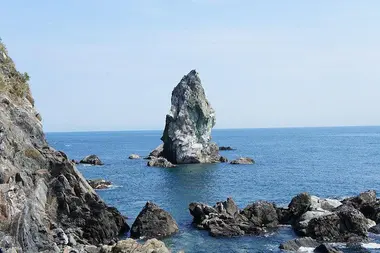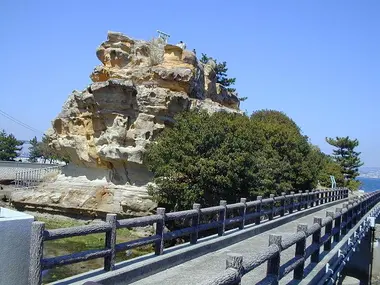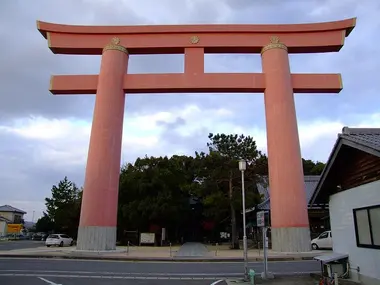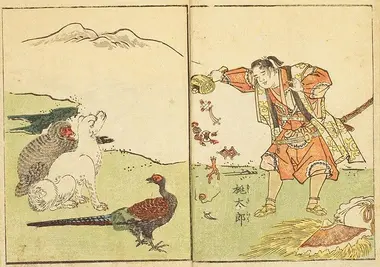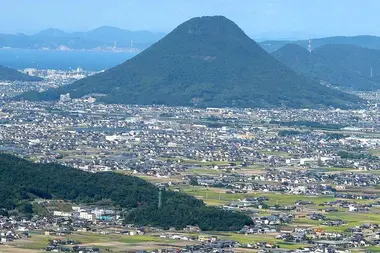The myths of the islands of the Seto Inland Sea 瀬戸内海の島々の神話
- Published on : 10/05/2019
- by : S.V.
- Youtube
Mythical islands
Demons, ghosts and spirits; historic Dantesque battles; pirates and brave warriors, Japanese myths and folklore ... The Seto Inland Sea is at the heart of many legends, famous throughout the archipelago. In four chapters, Experience Japan introduces you to these extraordinary stories. To start this trip, let's explore three myths related to the islands and islets of the Seto Inland Sea.
Onokoro jima, the first island of Japan
According to the legend of kuniumi, or "birth of the country" , the Seto Inland Sea is home to an island considered to be the first island created by the gods , or the mythical birthplace of Japan. The Kojiki, the "Chronicle of ancient things" dated 712, relates this myth of the birth of the Japanese archipelago which occurs after the legendary birth of the celestial and terrestrial world and the birth of the first gods in Tenchikaibyaku , the Japanese myth of creation.
The deities Izanagi and Izanami were instructed by the other kamis of Heaven to give a solid form to the Earth which until then was empty and formless like "a jellyfish floating on the sea". Posted on the ame no ukihashi , the "floating bridge of heaven" , they forcefully moved this chaotic mass with the help of the soul no nuhoko , a spear covered with precious stones.
As they waved and lifted the spear, drops of water flowed from it. While falling, these small drops of salt water formed the first island of the archipelago, the island of Onokoro or "first dry land".
Izanagi and Izanami went down to this island. There they built a great palace and the Soul no mihashira , the august heavenly pillar . It is by turning around this pillar in opposite directions that the two deities would have united and gave birth to children. They then created eight other islands: Awaji-no-ho-no-sawake-no-shima (Awaji island), Iyo-no-futana-no-shima (Shikoku), Oki-no-mitsugo-no-shima ( the Oki Islands), Tsukushi-no-shima (Kyûshû), Iki-no-shima (Iki Island), Tsu-shima (Tsushima Island), Sado-no-shima (Sado Island), Ohoyamatotoyoakitsu-shima (Honshu).
On reading this myth, you are probably already engaging in the following questioning: where is the island of Onokoro located? On this subject, the answers differ. While some Japanese consider Onokoro Island to refer to Awaji Island, others consider it to be another, much smaller place.
Thus the great scholar Motoori Norinaga (1730 - 1801) wrote in his commentary on the Kojiki that the island of Onokoro was certainly one of the small islands close to the island of Awaji like Nushima or Tomogashima.
Today, three places claim to be the first island of the archipelago: Nushima, Eshima and the Onokorojima shrine .
Nushima is a small island located 10 kilometers south of Awaji Island. South-east of Nushima, in the waters of the Pacific Ocean, stands a strange rock, 30 m high, called Kamitategami-iwa . The latter has a heart-shaped mark in its center and is said to be the Soul no mihashira , the pillar around which Izanagi and Izanami have united.
In the immediate vicinity of the port of Iwaya, at the northern end of Awaji Island, Eshima is a small sandstone islet eroded by wind and waves . Considered by locals to be the island of Onokoro, Eshima has a small shrine at its top.
The Onokorojima Shinto shrine is dedicated to Izanagi and Izanami. Although today located on the mainland, it was originally in the middle of the ancient Mihara cove which contributed to its assimilation to the island of Onokoro. In addition, there is a monument nearby which is perceived as the remnant of the ame no ukihashi, the "floating bridge of the sky".
Onigashima, the island of ogres
Onigashima, or the Island of the Ogres , is another mythical island in the Seto Inland Sea . Its notoriety, Onigishima owes it to the most popular of Japanese tales: Momotaro .
- To discover: Five famous Japanese legends
This boy born in a peach was picked up as a baby by an elderly couple as the fruit flowed down the river carried by the current.
A few years later, the young boy revealed his Herculean strength by easily bringing back an entire tree as firewood.
One day, Momotaro left his parents to go and fight a horde of demons who lived on the island of Onigashima . Along the way, he encountered a dog, a monkey and a pheasant who promised to help him in his difficult quest.
Once on the island, the troops found themselves in front of an imposing fortified gate. The three accomplices were then of a precious help: in the air, the pheasant kept watch; the ape, clever, pulled the bolt and the dog pushed the clapper. Once inside the ogres' lair , the four of them engaged in a fierce battle that they emerged victorious. Momotaro gathered all the wealth plundered by these demons, loaded them onto a cart and r entered his village accompanied by his three new friends where they lived happily together.
No need to rush over a map to look for this island of demons; it does not exist ... well not under this name in any case!
Onigashima Island is traditionally associated with Megijima Island, an island in the Seto Inland Sea north of Takamatsu Town . Although this tale has been popular since the Edo period (1603-1868) , this connection with the island of Megijima is quite recent.
It is indeed at the beginning of the twentieth century that we assimilated Megijima Island storytelling after a local researcher named Sentaro Hashimoto discovered vast artificial caves atop Mount Washigamine.
Converted into a tourist attraction since 1931, each year these caves welcome many tourists who come to see the oni defeated by the hero of their childhood.
- To read: Get to know more about Japan
The tearai oni
On the island of Shikoku , legend has it that a colossus demon used to wash his hands in the waters of the bay between Takamatsu and Marugame . One foot firmly anchored on the heights of each town, he then spanned the Seto Inland Sea . Thus positioned, he could happily plunge his hands into the waters of the bay.
This giant-looking demon is called tearai oni, the "demon washing his hands" . It is described in the Ehon hyaku monogatari or "Book of pictures of a hundred stories", a bestiary of Japanese monsters, yokai, oni, spirits and ghosts produced in 1841 by Takehara Shunsen, a painter from Osaka.
Letearai oni lived in the former province of Sanuki (now Kagawa prefecture) .
This giant was able to span straits and ride mountains; the amplitude of his legs allowing him to cover a distance of 3 ri, or 12 km! Local stories report that Sanuki's demon would have lived in the mountain, not far from the town of Marugame . He got out whenever he wanted to wash his hands and drink in the bay.
At the summit of Mount Iinoyama between Marugame and Sakaide, rocks still bear the imprints of his hands and his enormous feet!
To know more :






